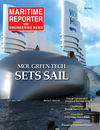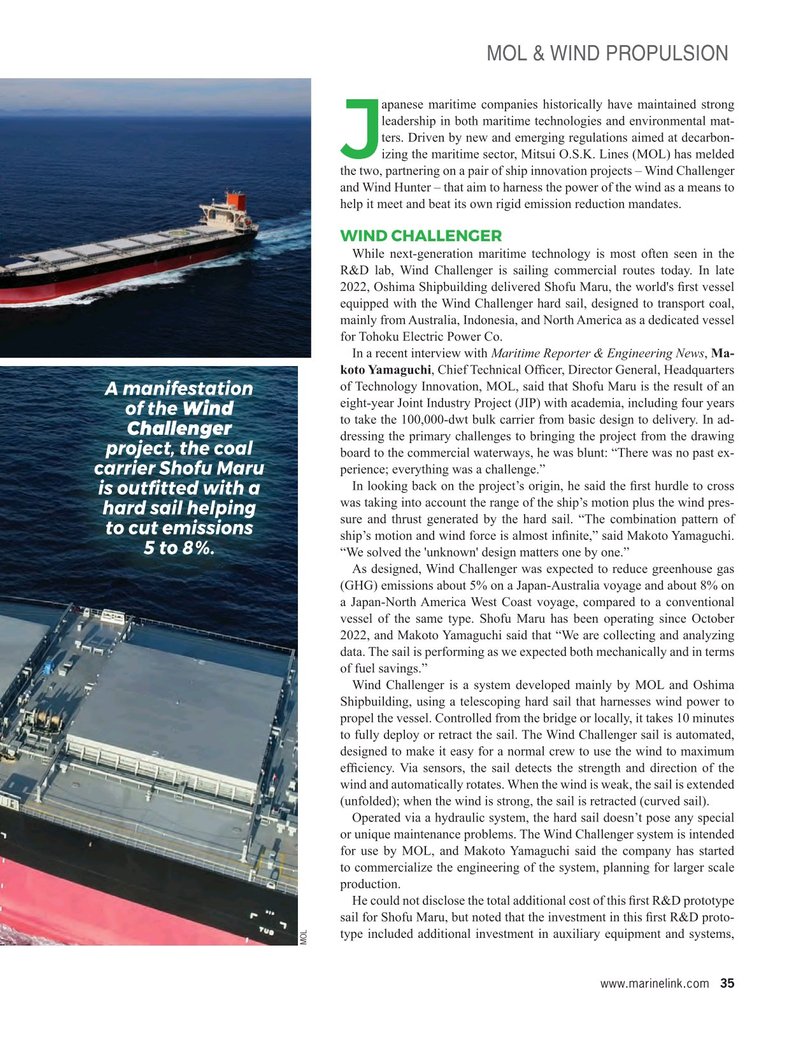
Page 35: of Maritime Reporter Magazine (May 2023)
Green Ship Technologies
Read this page in Pdf, Flash or Html5 edition of May 2023 Maritime Reporter Magazine
MOL & WIND PROPULSION apanese maritime companies historically have maintained strong leadership in both maritime technologies and environmental mat- ters. Driven by new and emerging regulations aimed at decarbon-
Jizing the maritime sector, Mitsui O.S.K. Lines (MOL) has melded the two, partnering on a pair of ship innovation projects – Wind Challenger and Wind Hunter – that aim to harness the power of the wind as a means to help it meet and beat its own rigid emission reduction mandates.
WIND CHALLENGER
While next-generation maritime technology is most often seen in the
R&D lab, Wind Challenger is sailing commercial routes today. In late 2022, Oshima Shipbuilding delivered Shofu Maru, the world's ? rst vessel equipped with the Wind Challenger hard sail, designed to transport coal, mainly from Australia, Indonesia, and North America as a dedicated vessel for Tohoku Electric Power Co.
In a recent interview with Maritime Reporter & Engineering News, Ma- koto Yamaguchi, Chief Technical Of? cer, Director General, Headquarters of Technology Innovation, MOL, said that Shofu Maru is the result of an
A manifestation eight-year Joint Industry Project (JIP) with academia, including four years of the Wind to take the 100,000-dwt bulk carrier from basic design to delivery. In ad-
Challenger dressing the primary challenges to bringing the project from the drawing project, the coal board to the commercial waterways, he was blunt: “There was no past ex- perience; everything was a challenge.” carrier Shofu Maru
In looking back on the project’s origin, he said the ? rst hurdle to cross is out? tted with a was taking into account the range of the ship’s motion plus the wind pres- hard sail helping sure and thrust generated by the hard sail. “The combination pattern of to cut emissions ship’s motion and wind force is almost in? nite,” said Makoto Yamaguchi. 5 to 8%.
“We solved the 'unknown' design matters one by one.”
As designed, Wind Challenger was expected to reduce greenhouse gas (GHG) emissions about 5% on a Japan-Australia voyage and about 8% on a Japan-North America West Coast voyage, compared to a conventional vessel of the same type. Shofu Maru has been operating since October 2022, and Makoto Yamaguchi said that “We are collecting and analyzing data. The sail is performing as we expected both mechanically and in terms of fuel savings.”
Wind Challenger is a system developed mainly by MOL and Oshima
Shipbuilding, using a telescoping hard sail that harnesses wind power to propel the vessel. Controlled from the bridge or locally, it takes 10 minutes to fully deploy or retract the sail. The Wind Challenger sail is automated, designed to make it easy for a normal crew to use the wind to maximum ef? ciency. Via sensors, the sail detects the strength and direction of the wind and automatically rotates. When the wind is weak, the sail is extended (unfolded); when the wind is strong, the sail is retracted (curved sail).
Operated via a hydraulic system, the hard sail doesn’t pose any special or unique maintenance problems. The Wind Challenger system is intended for use by MOL, and Makoto Yamaguchi said the company has started to commercialize the engineering of the system, planning for larger scale production.
He could not disclose the total additional cost of this ? rst R&D prototype sail for Shofu Maru, but noted that the investment in this ? rst R&D proto- type included additional investment in auxiliary equipment and systems,
MOL www.marinelink.com 35
MR #5 (34-49).indd 35 5/5/2023 8:35:16 AM

 34
34

 36
36
